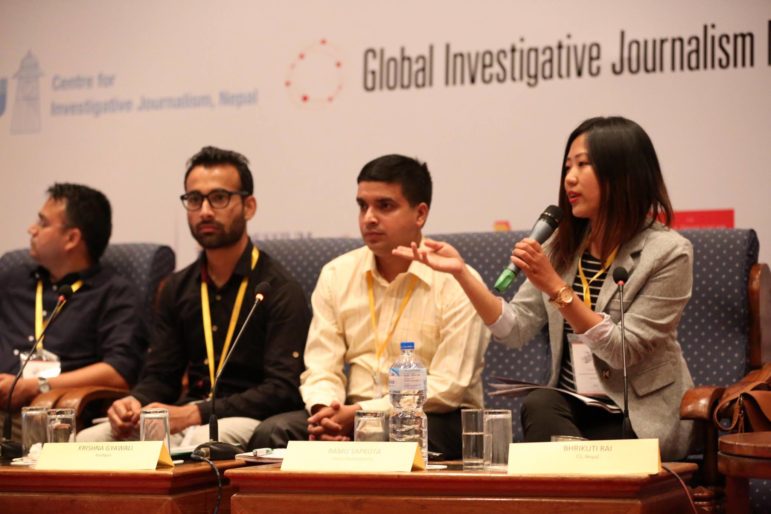
Investigating Nepal. Photo: Milan Poudel.
The last two decades have been challenging ones for Nepal, with the country witnessing a decade-long violent conflict and another ten years of unstable political transition. It is during these difficult years that Nepal’s media have come of age, resisting pressures ranging from newsroom censorship by the state to physical attacks against reporters by rebel Maoists. From exposing wartime atrocities to investigating corruption in Nepal’s leading institutions, including the Supreme Court of Nepal, investigative journalism is slowly but surely establishing itself in Nepal.
In an engaging session at the Second Asian Investigative Journalism Conference in Kathmandu, three of the country’s top investigative journalists shared their experiences, with discussions ranging from Nepal’s corrupt medical sector to the abuse of authority by the country’s Commission for the Investigation (CIAA).
Ramu Sapkota of the popular Nepali newspaper Himal Khabar Patrika has been relentless in covering Nepal’s corrupt medical education system.
“When I went on investigating the negligence in hospitals, I started finding more loopholes and wondered if there was a problem in the medical system itself,” said Sapkota. “I followed the paper trail, verified if the doctors were registered with the Nepal Medical council, and finally did a sting operation, pretending to an agent.”
Sapkota’s investigation found registration of ineligible medical colleges and fake doctors, and most recently admission of Nepali students under false nationalities, mostly as Indians because Indian nationals do not have to appear for the medical entrance test.
Krishna Gyawali, a reporter for Nepal’s largest daily Kantipur, spoke about his most recent investigative series on abuse of power by the CIAA. His story has faced several challenges.
“The authority which is supposed to investigate wrongdoings and corruption itself is abusing power and committing irregularities and when we reported about it there were threats,” said Gyawali. “You are being spied on, your every movement is being tracked and sources are scared to speak with you. It’s a psychological threat.”
He added: “Everyone is suffering from this parallel government situation.”
Gyawali was involved with investigating corruption after the Nepal Earthquake, in which he looked at the delay in infrastructure works funded by NGOs.
Session moderator Sudheer Sharma, editor-in-chief of Kantipur, added that the psychological fear among reporters is the biggest challenge in Nepali journalism.
Bhrikuti Rai of South Asia Check, a fact-checking site supported by Panos South Asia, was summoned by the court when her exposé of the corrupt chief justice was published. Rai’s investigation began with a fake doctor who had embezzled millions of rupees in donor funds and set up a hospital in Humla, one of Nepal’s remotest districts, despite having no medical qualifications. The doctor was arrested after the story but soon was released. Rai continued to follow the case and published a follow-up story with strong hints that the fake MD had paid a large sum of money to escape prosecution.
“I received a very aggressive phone call from the office of the Chief Justice telling me I’ll need to produce a written explanation,” Rai explained. “They threatened to bring me to the court but my editors stood beside me. Because our story was based on documents and facts, and the way we had worded the story, we knew we hadn’t crossed the line.”
These investigations have brought both positive and negative responses. The admission for medical education has now been tightened, while Nepal’s Central Investigation Bureau has launched an investigation into Nepali students using fake nationalities for admission to medical college.
But a lot of strong cases have fallen through, like that of the allegedly corrupt chief justice. Just two weeks after the story was published, Nepal was struck with a devastating earthquake, shifting the attention of the whole country to the immediate disaster.
The general lack of impact has also created a sense of frustration among investigative reporters in the country. Additionally, there are challenges of working on investigative projects in Nepal where paper trails are still vital in proving the credibility for investigation.
“Following the paper trail has both good and bad side,” Gyawali said. “Because documents are on actual paper, there aren’t many loopholes for questions to arise later, and that becomes a good way to secure yourself.”
“On the other hand, despite democracy in Nepal, a lot of acts are carried out verbally, without any proof, making it very difficult to track them, especially in the case of the CIAA after we started investigating them.”
Gyawali added that Nepal has no strong right to information law, and that open records are not that available.
The audience at the session also raised the issue of self-censorship among the news media. Editor Sharma, however, replied that it is not the case with all media groups, while Rai pointed out Nepali media’s reliance on a limited pool of advertisers leads to self-censorship at times.
However, the reach of social media has also created opportunities for investigative reporting. With more than 5 million Nepalis on Facebook, it has become a powerful tool. Another force the panelists mentioned is the nonprofit Centre for Investigative Journalism, Nepal, the second oldest investigative center in Asia, which has partnered on several of the investigations discussed.
“We are now empowered by digital tools and we have the medium at our disposal and lots of ways to engage with the audience,” Rai noted. “As Nepali journalists I hope we can capitalize on the power of technology to eventually lead to the kind of impact we want.”
 Sonia Awale is a Nepal-based freelance journalist with interests in science, health, and the environment. A recent graduate of the Journalism and Media Studies Centre at Hong Kong University, she has worked with Nepali Times, Malaysiakini, and China Daily.
Sonia Awale is a Nepal-based freelance journalist with interests in science, health, and the environment. A recent graduate of the Journalism and Media Studies Centre at Hong Kong University, she has worked with Nepali Times, Malaysiakini, and China Daily.
